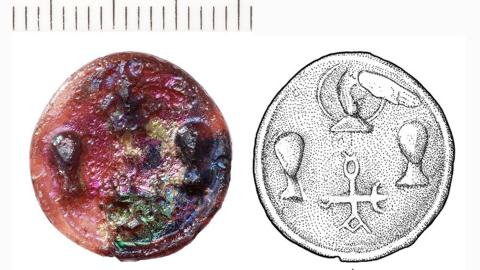
Rare Byzantine-Era Discovery Points to Early Church Built on Temple Mount Before Muslim Invasion
The recent discovery of two Byzantine-era coin weights is pointing to the possibility of a Christian presence on the Temple Mount before the Muslim conquest of Jerusalem in the seventh century, according to an archeological research journal.
The Temple Mount Sifting Project announced last week the discovery of two unique Byzantine coin weights, both of rare four keration denomination (about 0.6 grams).
"The first is made of purple glass and bears the impression of a known Imperial stamp, suggesting that it was probably manufactured in the Byzantine capital, Constantinople, and came to Jerusalem before the Muslim conquest," the organization describes.
***Please sign up for CBN Newsletters and download the CBN News app to ensure you keep receiving the latest news from a Christian perspective.***
"The second, made of brass, bears a hitherto unknown Greek Kappa Delta (ΚΔ) marking in silver inlay, indicating that it is also of the four keration denomination," it continued.
The project directors Gabriel Barkay and Zachi Devira, along with archaeologist and researcher Haim Shaham, published the latest findings in the Israel Numismatic Research journal.
The group believes the artifacts were most likely used as official imperial weights that were required by 6th-century Byzantine law to be present in major churches.
"For example, in 545 CE Emperor Justinian ordered that an official set of weights were 'to be preserved in the most holy church of each city'. It is possible, if not likely, that at least one of the Temple Mount weights discovered by the TMSP was one of these 'official weights'. In the case of the glass weight, it was issued by a high-ranking official of the Byzantine Empire and manufactured in a central workshop," the researchers explain.
The findings are rare as they belong to a series of previous discoveries from a sifting project that began in 2004.
According to All Israel News, the sifting project began an attempt to save tons of dirt and debris forcefully extracted by heavy trucks from the Temple Mount area and thrown towards the walls of the Old City.
Removing the dirt was an illegal act conducted by the Muslim Waqf–a religious organization that managed the maintenance of the Temple Mount.
The move angered Israelis who claimed that the Waqf prioritized Islamic interests under the noses of Israeli authorities and the Israel Antiquities Authority (IAA).
As a result, researchers are now forced to sift through dirt that was not scientifically excavated from its original context, which makes this project a little unusual.
Since 2004, archaeologists have discovered finds that are related to ancient Byzantine churches, including Byzantine floor tiling, and Tesserae chancel screens or small mosaic square stones.
"...Based on historical records, the discoveries from the Byzantine period can be related to Jerusalem's Christian inhabitants throwing debris and (trash) on the Mount. Perhaps these artifacts can be associated with the debris of several main churches that were destroyed and moved to this empty and open space at the southern part of the Temple Mount following the Sassanid-Persian conquest of Jerusalem in 614 A.D.," wrote Belgian-Israeli archaeologist Aaron Goel-Angot.
However, the fact that the sifting project is uncovering items from a non-scientific excavation coupled with the inability to associate the finds with a specific archaeological layer, is casting a shadow of doubt for archeologists.
But researchers are more convinced than ever that a church stood on the Temple Mount.
"We have all this Byzantine material which shows that something was going on, but up until a decade ago, the consensus was that during the Byzantine period, the Temple Mount was desolate. But actuality, a lot was going on during the Byzantine era, and from what we have found, it can be comfortably associated with a church," said Shaham, co-author of the INS article and an expert on ancient coinage.




